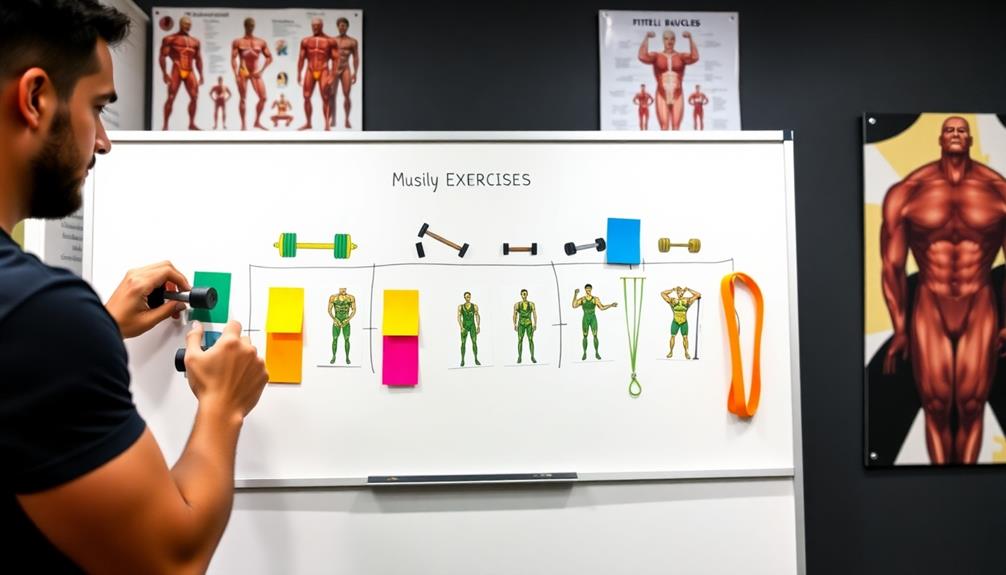To craft the best resistance training workout plan, start by defining your fitness goals and evaluating your current level. Choose suitable exercises that target all major muscle groups, and determine your ideal training frequency. Set ideal training volume, incorporating progressive overload to challenge your muscles. Schedule sufficient rest and recovery time between sessions. Track your progress consistently, and adjust your plan regularly to prevent plateaus. Don't forget to include proper nutrition and hydration to support your efforts. By following these steps and staying committed, you'll be well on your way to achieving your fitness objectives. The journey to your desired physique awaits.
Core Insight
- Define specific fitness goals and assess current fitness level to tailor your plan effectively.
- Choose exercises focusing on compound movements and all main muscle groups.
- Set appropriate training frequency, starting with 2-3 workouts per week for beginners.
- Determine training volume based on experience, starting with 1-2 sets of 8-12 reps per exercise.
- Regularly adjust your plan to challenge muscles, prevent plateaus, and maintain motivation.
Define Your Fitness Goals

To create an effective resistance training plan, start by clearly defining your fitness goals. Decide what you want to achieve, whether it's building muscle, getting stronger, improving endurance, or losing fat. Your goals will determine how you structure your workouts. When choosing resistance tubes, look for a range of resistance levels. This will let you make your workouts harder as you get stronger and progress towards your goals.
Set both short-term and long-term goals. A short-term goal could be increasing your bench press by 20 pounds in three months. A long-term goal might be competing in a bodybuilding competition next year. Be specific and realistic when setting your goals.
Assess Your Current Fitness Level

Assess Your Current Fitness Level
Before you start your fitness journey, it's important to know where you stand. Checking your fitness level gives you a starting point for your plan and helps you see progress. To begin, measure key areas of fitness:
- Strength: See how much weight you can lift for main exercises
- Endurance: Time yourself doing a specific exercise to see how long you can keep going
- Flexibility: Check how far you can move your joints
Compression sleeves can help support muscles and improve blood flow during your tests. They provide targeted compression to specific areas.
You can do these tests at home or with the help of a fitness expert. Be honest with yourself about your current level. It's okay if you're not where you want to be yet – that's why you're making this plan. Accurate information will help you create a better workout strategy. Everyone has to start somewhere, and regular check-ins will show you how much you're improving over time.
Choose Appropriate Exercises

When choosing exercises for your resistance training plan, focus on compound movements that work multiple muscles at once. Squats, deadlifts, bench presses, and rows are great choices. They help you build muscle and strength effectively. Resistance tubes offer a wide range of exercises for your upper body, lower body, and core. You can easily adjust the resistance by stacking the tubes as you get stronger.
Make sure to include exercises for all the main muscle groups: legs, chest, back, shoulders, arms, and core. A balanced approach is key, so don't skip any areas. If you have specific goals, like better posture or fixing muscle imbalances, choose exercises that target those needs.
If you're new to resistance training, start with bodyweight exercises or machines to learn proper form. As you get better, you can move on to free weights and more advanced movements. The most important thing is to choose exercises you can do consistently with good technique.
Determine Training Frequency

Deciding how often to train is a key part of making your resistance workout plan. How often you train depends on a few things:
- Your current fitness level
- Your goals
- Your schedule
Most people should aim for 2-4 resistance training workouts per week. Make sure to have at least one rest day between workouts so your muscles can recover. Resistance bands are a great option for your workouts, especially at home. They are portable, have different resistance levels, and work well for many types of exercises.
When making your plan, think about:
- Your fitness level and how well you recover
- Your specific goals, like strength, muscle gain, or endurance
- How much time you can realistically spend training each week
If you're new to resistance training, start with 2-3 workouts a week. You can add more as you get stronger. People with more experience may do well with 3-4 workouts per week. The most important thing is consistency. Choose a number of workouts you can stick with long-term. As you make progress and recover, you can adjust your plan if needed.
Set Optimal Training Volume

Setting the right training volume is key to getting the most out of your resistance workouts. Volume is the total amount of work you do, usually measured by sets and reps. If you're new to resistance training, start with 1-2 sets per exercise and aim for 8-12 reps. As you get stronger, you can bump it up to 3-4 sets. When picking resistance tubes, think about the resistance levels and range so you can progress as you get stronger. This lets you change your workout intensity over time.
Think about your goals when deciding on volume. For muscle growth, shoot for 10-20 sets per muscle group each week. For strength, do fewer reps (3-5) with heavier weights and 3-5 sets. But remember, more isn't always better. Too much volume can lead to overtraining and injury.
Keep an eye on your progress and adjust as needed. If you're not seeing results, slowly increase your volume. If you're feeling too tired, cut it back. Pay attention to your body and find the right balance that challenges you without burning you out.
Plan Exercise Order

When planning your resistance training, structure your workout for best results. Start with compound exercises like squats or bench presses that work several muscles at once. Do these first when your energy is high. Then do isolation exercises like bicep curls or leg extensions for specific muscles.
To add variety and challenge, especially for isolation moves, try using resistance bands. Bands come in different strengths, so you can make exercises harder as you get stronger.
To decide on exercise order, think about:
- Your goals (getting stronger, building muscle, improving endurance)
- Which muscle groups you're focusing on
- What equipment you have
Double check your plan for any issues or ways to improve flow. Make sure each exercise fits your overall goal.
Incorporate Progressive Overload

Applying progressive overload is essential for continuous muscle growth and strength gains. This means slowly increasing the challenge on your muscles over time. There are several ways to do this:
- Increase the weight you lift by a small amount each week
- Do more reps with the same weight, like going from 8 to 10 reps
- Add an extra set to your exercises
- Slow down the speed of your reps to increase time under tension
- Train the muscle group more frequently, like 3 times per week instead of 2
Pick one method and focus on it for a few weeks before changing things up. The key is being consistent and always pushing yourself a bit more than last time. This keeps your muscles adapting and growing stronger over the long-term.
Schedule Rest and Recovery

Scheduling rest and recovery time is key to getting the best results from your resistance training. Your muscles need time to repair and get stronger after tough workouts. Rest each muscle group for at least one full day between training sessions. On rest days, you can still exercise by focusing on different muscles or doing light cardio. Adding foam rolling to your recovery plan can help improve blood flow, reduce soreness, and boost muscle recovery and flexibility.
For proper recovery, remember to:
- Sleep 7-9 hours per night
- Drink plenty of water and eat a balanced diet
- Try active recovery like stretching or yoga
Track Your Progress

Tracking your progress is crucial for staying motivated and making sure your resistance training plan works. First, record your starting measurements, like weight, body fat percentage, and muscle sizes. Log your workouts, including the exercises, weight, sets, and reps. This will help you see improvements over time. Taking photos every few weeks can also show changes in your body. Fitness apps or wearable devices can track your heart rate, calories burned, and other important numbers. Don't forget to retest your one-rep max on main lifts to measure strength gains.
Adjust and Refine Regularly

To keep your resistance training effective, you need to make regular adjustments. Three important reasons for this are:
- Your body adapts to exercises over time
- Your fitness goals may change
- Your schedule or lifestyle can vary
As you get stronger, you'll need to change your workout to continue challenging your muscles. This prevents progress from stalling. Just like how you choose the right compression level for sleeves based on your needs, you should adjust your training intensity to fit your current fitness and goals.
Here's how to adjust your plan:
- Reevaluate your goals every 4-6 weeks
- Change up exercises, sets, reps, or weights
- Pay attention to your body and modify intensity if needed
Don't hesitate to make changes when you need to. If you're not getting results or feeling motivated, try new exercises, change how often you work out, or use different training methods. Your resistance training plan should develop along with you. Consistently refining your approach will help you progress and stay committed to your fitness journey.
Frequently Asked Questions
How Long Should Each Resistance Training Session Last?
You should aim for 45-60 minutes per resistance training session. It's enough time to warm up, complete your exercises, and cool down. Don't exceed 90 minutes, as it may lead to overtraining and decreased motivation.
What's the Ideal Ratio of Compound to Isolation Exercises in a Workout?
You'll want to aim for a 2:1 or 3:1 ratio of compound to isolation exercises in your workout. Prioritize multi-joint movements, but don't neglect targeted exercises. This balance will help you build overall strength and address specific muscle groups effectively.
Should I Use Free Weights or Machines for Resistance Training?
You should use both free weights and machines for resistance training. Free weights offer more functional movement and engagement of stabilizing muscles, while machines provide isolation and safety. Combine both for a well-rounded workout that suits your goals.
How Do I Prevent Plateau in My Resistance Training Progress?
To prevent plateau, you'll need to regularly change your routine. Vary your exercises, adjust sets and reps, increase weights progressively, and alter rest periods. Don't forget to challenge yourself with new techniques like supersets or drop sets.
Is It Necessary to Change My Workout Routine Periodically?
Yes, it's necessary to change your workout routine periodically. You'll prevent plateaus, challenge your muscles in new ways, and keep your workouts engaging. Aim to modify exercises, sets, reps, or intensity every 4-6 weeks for best results.

